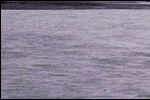Soil
The
Arctic Coastal Plain consists of marine (carried into seas by streams and beach
erosion), fluvial (carried by flowing river water), alluvial (carried by river
water that gradually loses velocity), and aeolian (carried by wind) deposits
from the rising of the Arctic Sea on the plain in the mid/late Quaternary Age.
The
Coastal Plain is dominated by lakes and poorly-drained soils, while the Brooks
Range has less lakes and more well-drained soils (due to river flow).
Poorly-drained soils mostly result from the predominance of permafrost, which
restricts water flow in and out of the soil, as well as impermeable bedrock in
more upland areas.
Soil Types of the Area
*Pergelic Cryaquepts: low-lying, seasonally flooded,
shallow surface mat of partially decomposed organic matter grading into dark
gray sandy loam.
*Histic Pergelic Cryaquepts: lowlands, slightly to
moderately decomposed organic matter grading into dark green-gray silt loam.
Pergelic Cryofibrists: poorly-drained, organic, made
of thick layer of sedge and moss peat.
Typic Cryochrepts/ Alfic Cryochrepts/ Aeric
Cryochrepts
*Principle
soils
“Histic”
indicates that the soil is shallow with poorly aerated organic material;
“Pergelic” refers to temperature “regime,” indicating the presence of
permafrost; and “Aquept” suggests poor drainage. The soils of the 1002 region
are generally loamy, gravelly, and from nearly level to hilly/steep
association.
Vegetation vs. Soil
|
Site
|
Dominant Vegetation
|
Soil Suborder
|
Max thaw depth (m)
|
pH
|
|
Tussock Tundra
|
Eriophorum
Dwarf Shrubs
Sphagnum
|
Pergelic Histic Cryaquept
|
.4
|
6.4
|
|
Heath
|
Dryas
Betula Salix
Ericads
|
Pergelic
Ruptic Entic
Cryumbrept
|
2-5+
|
4.2
|
|
Shrub-Lupine
|
Salix Cassiope Lupinus
|
Pergelic
Histic Cryaquept
|
1-2+
|
6.9
|
|
Equisetum
|
Lupinus
Grasses, Sedges
Equisetum
|
Pergelic
Histic Cryaquept
|
.45
|
7.4
|
|
Wet sedge
|
Carex
Eriophorum
|
Pergelic
Cryohemist
|
.55
|
6.6
|
|
Willow
|
Salix
Betula
Lupinus
Sphagnum
|
Pergelic
Cryofluvent
|
+
|
7.8
|
pH
The
soil pH ranges from approximately 4-8, depending on the soil type, topography,
and amount of disturbance to which it was subject. High weathering and
cryoturbation generally makes the soil less acidic, introducing more basic
materials to the soil matrix. Frost boils, on the other hand, lowered the pH by
moving the organic layer deeper in the soil and increasing the depth of thaw.
The pH of the soil has a clear relation to the species diversity and density
within the area.
Element/Nutrient Composition and the Issue of Heat
Arctic
soils consist of many trace elements, as well as very large quantities of the
carbon, nitrogen, and phosphorous very important to the ecosystem. These
elements are essential to processes of mineralization and respiration and
nutrient distribution, and because decomposition processes of Arctic tundra
soils respond to temperature increase more than other types of region soils,
they stand to be very greatly affected by both global warming and other sources
of heat input. Increased water flow which can result from melting of permafrost
also temporarily increase nutrient distribution and lengthen the growing season
for certain plants, particularly E.
vaginatum, a species of cottongrass sedges. Increased soil flow increases
heat flux, which leads to deeper thaw and therefore magnifies the effect.
Concern
also arises that the Arctic soils may contribute to greenhouse gas emissions
due to this increase in decomposition of organic matter. Most soil organic
carbon is found in the active layer of the soil, and it varies in amount
depending on such formations as ice wedges, which melt to form polygons with
either “high-centers” or “low-centers” that drain in different ways. The
proportion of soil organic carbon in the upper permafrost is directly related
to the influence of soil moisture on active-layer thickness in that better
drained soils have more carbon in the active layer. With global warming and
increased heat, the active layer thickness may increase by 20-30%, increasing
cryoturbation, thermal erosion, and intensified thaw-lake cycles. Thaw lakes
contain peat in frozen subsoil which would also decompose when melted,
increasing emissions.
 Next: Nutrient Cycles>>
Next: Nutrient Cycles>>







